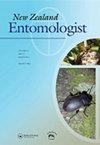A new species and lectotype designations for New Zealand Hydora (Elmidae: Larainae) with a world checklist
IF 0.4
4区 农林科学
Q4 ENTOMOLOGY
引用次数: 3
Abstract
The family Elmidae is represented by a single genus Hydora Broun in New Zealand; they are the most abundant Coleoptera encountered in streams there. There are nine previously described species of Hydora, six from New Zealand, to which we add Hydora musci sp. nov. based on larvae and adults. Hydora musci can be distinguished from all remaining New Zealand species by the following characters: adult with pronotum with weak lateral transverse depression, pronotal lateral carina incomplete extending from posterior margin approximately two-thirds anteriorly, sublateral longitudinal carina less than one-third of the average carina length; elytral punctate striae poorly developed, elytral setae no longer than one-third width of eye, outer surface of mesotibia polished, surface of metatibia not polished; larva with thoracic and abdominal segments bearing single dorsal and lateral protrusions (often reduced), tooth absent on anterior margin of head, laterotergites complete on abdominal segments I and II, complete to incomplete on segments III to IV. Most specimens of H. musci were found in stable tributary streams containing bryophytes in the Arnold River Catchment 31 km inland from Greymouth on the West Coast of the South Island. Larvae are grazers that co-exist with adults at the stream margins and in splash zones associated with bryophytes attached to large boulders. A catalogue of the world Hydora species is included, and lectotypy is established for the following New Zealand species: Hydora subaenea Broun, Hydora picea (Broun), Hydora obsoleta Broun, Hydora nitida Broun, Hydora lanigera Broun and Hydora angusticollis (Pascoe). http://zoobank.org/urn:lsid:zoobank.org:pub:8EB6FA4E-BD27-4EAD-8113-977518118CBD文章题目新西兰海蛾属(鞘翅科:海蛾科)一新种及新种型命名及世界名录
Elmidae科在新西兰以Hydora brown一属为代表;它们是那里溪流中数量最多的鞘翅目昆虫。海多拉有9种,其中6种来自新西兰,我们根据幼虫和成虫添加了Hydora musci sp. nov。在新西兰的所有其他种类中,肌肉水龙的特征如下:成虫的前前额横向凹陷弱,前前额外侧隆突不完整,从后缘向前延伸约三分之二,下外侧纵隆突不到平均隆突长度的三分之一;鞘翅具点状条纹发育不良,鞘翅刚毛不长于眼的三分之一宽,中胫外表面擦亮,跖骨表面未擦亮;幼虫胸腹节有单一的背侧突出(通常减少),头部前缘无牙齿,腹节I和II上有完整的侧体,节III到IV上有完整到不完整的侧体。大多数musci的标本是在南岛西海岸格雷茅斯内陆31公里的阿诺德河流域含有苔藓植物的稳定支流中发现的。幼虫是食草动物,与成虫共存于溪流边缘和与附着在巨石上的苔藓植物有关的水花区。本文编制了世界水螅物种目录,并建立了以下新西兰水螅种的选型:subaenea brown、Hydora picea (brown)、Hydora obsoleta brown、Hydora nitida brown、Hydora lanigera brown和Hydora angusticollis (Pascoe)。http://zoobank.org/urn:lsid:zoobank.org:pub:8EB6FA4E-BD27-4EAD-8113-977518118CBD
本文章由计算机程序翻译,如有差异,请以英文原文为准。
求助全文
约1分钟内获得全文
求助全文
来源期刊

New Zealand Entomologist
ENTOMOLOGY-
CiteScore
0.70
自引率
33.30%
发文量
3
审稿时长
>12 weeks
期刊介绍:
The invertebrate diversity of New Zealand is of great interest worldwide because of its geographic isolation and geological history. The New Zealand Entomologist plays an important role in disseminating information on field-based, experimental, and theoretical research.
The New Zealand Entomologist publishes original research papers, review papers and short communications. We welcome submissions in all aspects of science regarding insects and arthropods in a New Zealand or Australasian setting. The journal’s subject matter encompasses taxonomy, phylogenetics, biogeography, biological control and pest management, conservation, ecology and natural history.
The journal is the official publication of the Entomological Society of New Zealand. Papers published or submitted elsewhere for publication will not be considered, but publication of an abstract or summary elsewhere (e.g. conference proceedings) does not preclude full publication in the New Zealand Entomologist. Accepted papers become copyright of the Entomological Society of New Zealand. The journal is published in English, but we also welcome publication of abstracts in Maori.
 求助内容:
求助内容: 应助结果提醒方式:
应助结果提醒方式:


